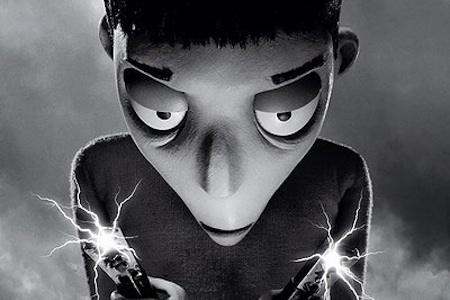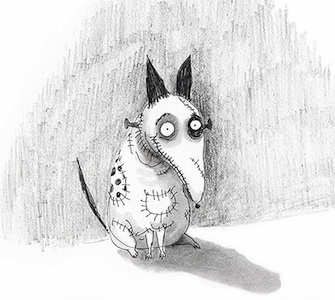Mary Shelley’s Frankenstein; or, the Modern Prometheus is broad allegory, and as allegory, it encourages re-examination, which brings on repetition. We can’t blame it for its progeny.
I realize in a time of remix culture calling anything “original” is a dicey proposition. Authors carry their influences; philosophers stand on each others’ shoulders, and filmmakers “borrow,” to put it nicely, heavily. And, sure, you can say one reference or a few can’t make a film into a Frankenstein monster, but 100 references surely made Tim Burton’s feature length Frankenweenie into one.
No matter how affectionate or blithe, Burton’s feature adaptation of his 1984 short is a beast of reconstituted parts. He apes the Universal monsters, themselves a reiteration of the shadowy dangers of German Expressionism, Sturm and Drang and E.T.A Hoffmann. He copies the welled eyes of waifish children a la illustrator/writer Edward Gorey. He makes light of his own catharsis with operatic tones—all meant to deflate the gravity of the catharsis intended. It’s not a quagmire exactly; it just seems to shoot itself in the foot. And that’s if you think it’s funny to begin with.
It’s strange to reconsider the 1984 short that was so feared by its financers (Disney) and sought after on VHS. It catalyzed a niche Burton would get to scratch years later. At the time it seemed like Burton’s “vision” (later comprising a market of its own) was less about reconstituting Caligari than it was about positing a uniquely self-aware tone. When the live-action Sparky-abomination squirted water from between its stitches, it was as macabre as absurd, and boasted a whimsy that could be compared to Day of the Dead art, if lacking in that form’s legacy of loss. (Feel free to resent the unearned pathos.)
With stop motion, Burton’s made his gaunt characters even more diminutive, effectively animating his own GashleyCrumb Tinies. Ed Gorey’s Alphabet book for adults listed the names of children who met their unfortunate and adorable demise in the vein of Hoffman’s cautionary Struwwelpeter, but Gorey was neither cautionary nor sincere, in fact he was snarking the death of children for laughs, and simultaneously lampooning Victorian dastardliness and melodrama. This isn’t far from Burton’s “kids’” book, The Melancholy Death of Oyster Boy, in which a couple births an oyster baby they’re told to eat to cure erectile dysfunction. It’s a cruel world for small, unorthodox creatures.
In the film within a film that begins 2012’s Frankenweenie, Victor Frankenstein’s toy Rodan hangs over a city made of housewares. Catherine O’hara says, “Oh that’s where my candlestick went,” as Sparky, costumed like one of O’Hara’s art pieces in Beetlejuice, leaps into the scene to save the toy town from its toy foe. It’s homey, it’s playful and, like a tiny commercial for the feature, it’s made of randomly found pieces.
Martin Landau voices Frankenweenie’s heroic outcast, Mr. Rzykruski, (sounds like Rice Crispy). A science teacher who speaks as if everything is a coarse translation shipped in from unspecified Eastern Europe, Rzykruski is passionate about science and maligned for talking down to disbelievers. He’s Vincent Price in spirit (if lacking in effete affectations) and a reminder that Price is to Burton what Bill Murray is to Wes Anderson: a distillation of conflicting moods, a kind of ethos incarnate. And while he (spiritually) holds the flashlight for our vexed hero Victor, he also becomes an icon of anti-success. If integrity is to be found among the forerunners, so is disappointment, the essence of life.
Victor’s experiment creates an aberration and hope at once—it also tests the limits of love and household appliances. Victor passionately cobbles together blenders and other conveniences of the domestic sphere to generate enough electricity (a vague enough element) and revive the corpse of his childhood joy: Sparky. The resurrection is poignant and no sooner is the dog up and enthusiastic than his articulate bits (tail, ear) erupt from him like so much drool. It’s a joke that couldn’t be made in live action for fear of going the way of Jan Svankmajer. The dog’s too endearing to be existential, and with no discernible tap into anything spiritual we don’t fear he’ll incur the angst of Frankenstein’s monster—the only part he’s borrowing is two bolts and a patch of quilting fabric so he’s unlikely to discover he’s got someone else’s facility with wind instruments. Yet, Sparky is not completely without association to other realms.
Else Van Helsing (Winona Ryder, not a vampire hunter) is the niece of the Mayor of New Holland; she’s still Lydia from Beetlejuice but here she trades her ties to Hades with a poodle named for his mistress. Her dog Persephone is Sparky’s almost GF. With a facile mix of early ’60s streamlining and a streaked beehive, the Bride of Frankenstein reference is overt enough to elicit laugher. The dogs’ interactions happen mostly around a gate that separates them: it’s our visual boundary between the living and the (un)dead and it highlights Frankenweenie’s lack of essence. In one exchange, Mr. Rzykruski characterizes love as a “variable” in Victor’s science experiment. His understatement is meant to be sweet but I think love is a variable Burton only remembers sharing with his characters and so really can’t share with us.
New Holland’s Mayor Burgemeister (Martin Short) is a kind of Heat Miser knock off, but with bigger PR problems and a prized garden of tulips (the flower most associated with mania). The town is a reference to Burton’s childhood Burbank and it provides a nod to the New Hollywood sign while justifying the appearance of conspicuous windmills—crucial if a town ever needs to burn a living aberration. And though Sparky never killed any flower bearing girls, Weird Girl kind of recalls Morticia Addams’ daisy bearing sister Ophelia and satisfies the duties of the prescient blonde; her cat Mr. Whiskers provides us a reference to Edward Gorey’s Gashleycrumb alphabet with his grody proclivity for initials.
Burton’s attachment to Frankenstein reaches more toward James Whale’s Frankenstein than Mary Shelley’s. The monster of the book is a self-discovering brute; he’s inarticulate and physical at first but later waxes poetic and suffers from his own self-discovery. In contrast, Whale’s grunting, tragic half-zombie operatically compels our sympathies without much dirtying of philosophical hands. As an animation for kids, it seems more appropriate for Frankenweenie to name check Shelley rather than tussle with the issues she raised, but did Burton have to make it so cutesy?
Apparently, of all the sea-spawned monsters in Ishiro Honda’s collection, Tim Burton’s 3-year-old loves Gamera most, so dad created a Honda surrogate, Toshiaki (James Hiroyuki Liao), to revive his pet turtle “Shelley” and capture it all on super-8. Toshiaki’s attempts to make a rocket-pack land Bob (Robert Capron) in an ambulance, but Bob’s up soon enough, and with a plan to test the world’s collective apprehensions about sea monkeys (Joe Dante grumbles; can’t justify Gremlin-based royalties). Victor’s parents hide from the monkeys in a phone booth a-la-Hitchcock and Bergemeister runs for the nearest port-a-potty…didn’t something like that happen in Jurassic Park? At this point we’re reaching Friedberg/Seltzer quantities of reference.
Nassur (also Martin Short) satisfies our Boris Karloff quotient, with a foreboding accent, up-lighting and a lisp. He’s designed with a flat head to invoke the supported skullcap of Whale’s Frankenstein monster and even gets a gag involving tissue paper and a Russian Doll decorated “sarcophagus.” Nassur’s friends revive recognizable animals, but he revives COLOSSUS! (you have to say it big to get the idea), a mummified larva with three legs, mismatched eyes and a previous life as a hamster. Nassur’s faith in this creature is so comprehensive he believes it can fight Shelley/Gamera, or at least he believes if he gives it enough bluster, big things can happen. But in this land, the small are devoured by the big (weather, beasts, parents) and usually to satisfy the whims of some cruel “order,” natural or otherwise. To refute the proclamation of one rotting, avant-garde fox: Chaos doesn’t reign, cruelty does. (Just a note: Rotting is what happens to dead things.)
“Frankenstein: or, The Modern Prometheus,” is an allegory so multipurpose it’s almost a nautilus shell of perfect construction—ironic since the titular subject is a perversion of carbon life forms. And it has a logical corollary in culture, an arena so overstuffed with itself that cultural products have taken to referencing each other in a kind of club-ritual. Like Pokémon, some movies suggest that declaring, “I am cinema” makes them such. Most would invoke Tarantino here because he’s so overt about his references as to look wholly unoriginal. You could argue he’s an exception to my larger claims of originality because he (in his way) infuses inferior films with an enthusiasm that somehow improves them. I’m not really a fan but a comparison viewing of 1978 exploitation film The Inglorious Bastards and his “remake” (in misspelled title only) proves this tidily. What Tarantino does, without being completely original, is share affection for his references while demonstrating a referent distance.
Frankenstein’s lack of originality makes him a smelly aberration society is bound to destroy, even as he’s proof reconstruction can trump reproduction and man can play God. Or rather, man can ape God by digging through his trash and applying a veneer of “science.” Think of the military applications! We could preserve generations of hour-glass figures with just a little digging. Imagine the headlines: Science Disinters “The Future!” Everyone deserves a second chance—and Disney knows how to capitalize—but isn’t it nice when the phrase “you never cross the same bridge twice” means something?





